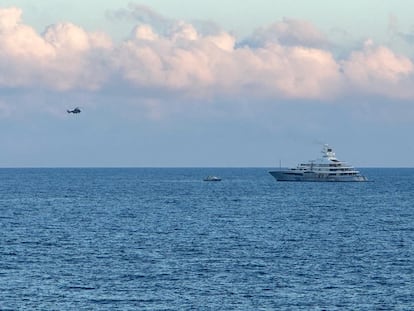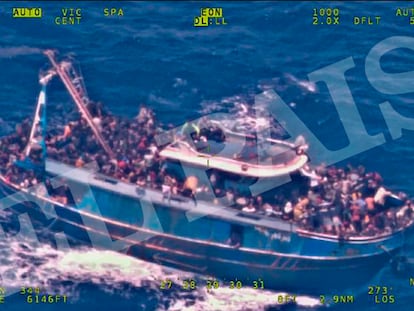Survivors of the shipwreck in the Mediterranean accuse Greek authorities: ‘The Coast Guard towed us at high speed, and we capsized’
An investigation by EL PAÍS together with Lighthouse Reports reveals inconsistencies in the official version of the catastrophic June 14 events that cost the lives of over 600 people. Several of the survivors’ official statements are identical, as if they were copied and pasted
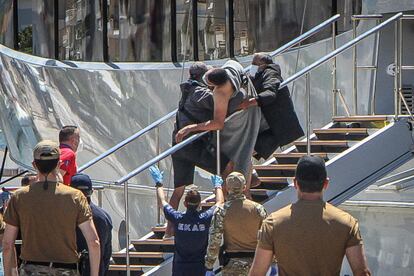
Seconds before plunging into the sea, Kamal, a 27-year-old Syrian refugee, looked at his watch. It was 2:05 a.m. on June 14. His body was sinking into the darkness alongside some of the 750 people who were traveling with him aboard an old blue fishing boat bound for Italy. “The Coast Guard towed us at high speed, and we capsized,” he says. The water, which had been calm until then, was filled with people desperately trying to save themselves, screaming, men tearing off their clothes to escape from others who were grabbing them to stay afloat...A short distance away, the Greek Coast Guard boat witnessed the scene. When the young man looked at his wrist again, now aboard the superyacht that rescued him, it was 4:15 a.m. “I’d been swimming for over two hours,” he recalls.
Testimony given by Kamal, a survivor of the tragic shipwreck that occurred three weeks ago in the portion of the Mediterranean known as the Ionian Sea—less than 80 kilometers from the Greek coast—contradicts the Greek authorities’ version of events. But Kamal is not alone. A joint investigation by EL PAÍS and Lighthouse Reports, Reporters United, Monitor, SIRAJ and Der Spiegel has interviewed 17 witnesses separately, and 16 offer the same account: when the trawler’s engine stopped working, a Coast Guard ship towed them with a rope at high speed. The trawler capsized. Some believe the Coast Guard’s botched action was an accident, while others believe it was intentional. Two survivors claim that they recorded the towing with their cell phones but complain that the Greek Coast Guard confiscated their devices. All of the interviewees requested pseudonyms for fear of reprisals.
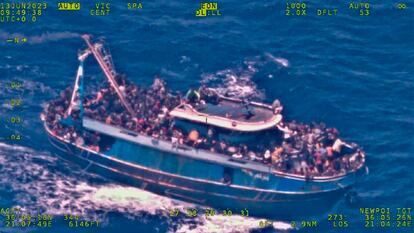
The ship had left Libya five days earlier. It was carrying around 750 people crammed together: Syrian, Afghan, Egyptian and Pakistani refugees. Men and women—several of whom were pregnant—as well as teenagers and children were trapped in the hold of the ship with no chance of survival. Only 82 bodies have been recovered. The presumed number of victims, surely over 600, already makes this the second worst shipwreck in the Mediterranean, behind an April 2015 shipwreck that left 1,100 dead.
For those who survived, the difference between life and death was a matter of €100 or €200, which the traffickers demanded from passengers who asked to travel on deck and not in the hold, a floating trap from which there was no way out.
The Greek government denies any responsibility, but it still has no answer to a key question: How could hundreds of people drown despite the fact that its Coast Guard was close to the trawler for hours? Serious accusations have emerged: was the Coast Guard responsible for the sinking of the boat? Did it delay its rescue even as people were drowning? Did it intend to prevent hundreds of migrants from disembarking in its territory at all costs?
Until today, there’s been no definitive evidence to refute the Greek version, but an increasing number of elements now cast doubt on it. The only open legal proceeding related to the case will try the nine alleged Egyptian traffickers who were on the ship.
This joint investigation by EL PAÍS with Lighthouse Reports and its partners provides new information that reinforces the accusations against the Greek authorities. The investigation reveals the hardships of a journey in which passengers had to drink urine and seawater; shows the modus operandi of the criminal organizations; and, above all, sheds light on the Coast Guard’s actions. Internal reports from Frontex, which flew over the area with a plane and a drone; documents from the court case; and 17 interviews with those who experienced the tragedy suggest that the Greek authorities never prioritized the rescue of that huddled and exhausted crowd.
Additionally, analysis of the statements that survivors made to the Coast Guard within hours of disembarking suggests that some of the testimony was copied and pasted identically into the files, possibly indicating manipulation of the facts.
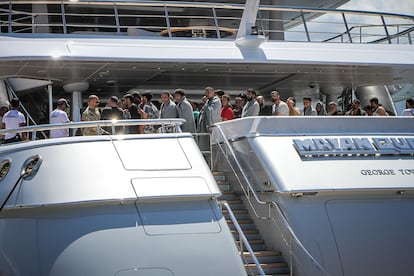
A luxury yacht to the rescue
The authorities’ reluctance to initiate a rescue operation, which already happened in the shipwreck off the Italian coast of Cutro in February, is a key element of what happened in this case. The Greek Coast Guard only activated the rescue of the trawler over 14 hours after the Greek and Italian maritime coordination centers located it sailing in precarious conditions. They only did so when the trawler—called Adriana—was already sinking.
Before the ship sank, a spokeswoman confirms, Frontex offered the Greek authorities air support. “But we didn’t receive a response,” she says. They did answer the offer to deploy a drone but directed it to another boat, off the island of Crete, where “80 people were in immediate danger.” When it returned, the rescue was already underway.
A 93-meter (305-foot) luxury yacht, the Mayan Queen IV played a crucial role in the Greek-coordinated operation; it lowered its lifeboat and assisted in the search for survivors. The testimony that its captain, Richard Kirkby, gave to the Greek authorities—to which this investigation had access—reveals that he received notice of the shipwreck at 2:30 a.m. and he was the first commercial vessel to arrive in the area at 2:55 a.m. If that time is accurate (the captain of an oil tanker who also participated in the search claims to have received the message at 2:12 a.m.), the alert would have been issued almost half an hour after the Adriana sank.
The captain stated that, guided by the cries for help, his crew pulled 15 castaways from the sea. Later, eight enormous ships participated in the search and rescue efforts with little success. When they arrived, the sea had already swallowed everything up; it seemed as if nothing had happened there.
At six o’clock in the morning, the British captain received an order by radio to pick up the people waiting on the Coast Guard ship and take them to port. Once the transfer had been made, a hundred people and four members of the Coast Guard set sail for Kalamata, four hours away. Asked if he wanted to add anything else to his statement, Kirkby nods. “Yes, I would like to say that in addition to the 10-15 people we rescued, my crew informed me that there were many more floating on the surface of the sea.”
This investigation conducted interviews with 16 survivors that provide conflicting accounts of what happened in the early hours of the morning of the shipwreck; only 104 people survived, while some 600 others sank into one of the deepest parts of the Mediterranean. Contradicting the official Greek account, witnesses claim that they did call for help, desperately and repeatedly. “At around 13:00 [1 a.m.] an airplane flew over us, and we started to make hand gestures asking for help. At that time, two people had already died of starvation, and we put the bodies in the captain’s cabin, on top of the boat, so that the plane could see them,” says Amin, a Syrian survivor in his 40s.
Three witnesses also claim that the Coast Guard ordered them to continue the journey to the Italian rescue zone, outside their jurisdiction. “Our agreement with the Greek Coast Guard was that we would follow their ship to Italian waters where there was a rescue ship that could take us to Italy. [The Greek ship] had a green light and we followed it until our engine stopped running,” recalls Manhal, a Syrian bricklayer in his 30s, who lost his brother in the shipwreck.
A deadly dragnet
A blue rope helps unravel the Greek authorities’ initial account of the events. At first, the Coast Guard denied having thrown a rope to the trawler, but as the survivors began telling journalists their account of events, the hypothesis that the Coast Guard did, in fact, tow the trawler gained traction. The people responsible for the rescue operation have finally acknowledged that they did throw a rope but insist that it was by no means intended to drag the vessel, much less to Italy. Among other things, the Greek authorities have claimed that the Italian search and rescue area was over 130 kilometers (81 miles) away, a distance that would require sailing for two to three days.
Hassan, a 23-year-old Syrian, describes the risky operation. “They told us that they would take us to the [Italian] rescue ship, which was sailing only two hours west. They towed us like a car. The first time, our boat almost capsized, but it stabilized. The second time, the boat tilted to the right and capsized; I didn’t even have time to make the decision to jump into the water. After cutting the rope, the Coast Guard boat started to pull away from us.” Several testimonies corroborate this version of events.
From the Malakasa refugee camp, located 40 kilometers (25 miles) from Athens, 26-year-old Syrian dentist Maher shares his memories of that early morning.” I was on deck when we capsized; I fell into the water and the boat made a huge wave that threw me about 30 meters [98 feet] away from it. It was pitch dark. The Greek ship stopped about 500 meters [1640 feet, or 1/3 of a mile] from us, maybe more. I’m still confused...why didn’t it come back? Why did they remain stopped? They could have saved many lives.”

The Greek Coast Guard is known to expel migrants and refugees from its waters and has been accused of similar actions in the past. Last year, the European Court of Human Rights condemned Greece’s behavior toward a boat carrying 27 Afghan, Syrian and Palestinian refugees that was sailing off the Greek island of Farmakonisi in January 2014. The Greek Coast Guard attempted to tow the overloaded boat until it capsized. Eleven women and children died in the wreck. Then, too, the Greek Coast Guard claimed that the refugees’ panic and sudden movement on board had caused the vessel to sink.
Beyond the Adriana, the Greek Coast Guard’s actions in the Aegean Sea have shaken Frontex. Violations of international law in its waters have led the border agency’s fundamental rights officer to recommend that it stop cooperating with Athens. The main concern is the documented practice of dragging groups of refugees out to sea and placing them in lifeboats that they take into Turkish waters. The New York Times reports that the official has called for the “strongest possible measures” to bring Greece back into compliance with the law.
Copied and pasted identical testimonies
The coast guard has claimed that the survivors’ testimonies, which were sparse at the beginning, have since been influenced by outside actors. “The change in the content of the statements coincides with the transfer of the witnesses to Malakasa to whom…members of NGOs and lawyers quickly gained access,” the Greek daily Kathimerini reported this week.
But analysis of the survivors’ statements to the Coast Guard indicates a different intervention. The official interviews contain at least four nearly identical statements about a key moment in the voyage and the shipwreck, despite the fact that the testimonies were given by four different people who had different translators. Moreover, in one case, a member of the Coast Guards acted as the translator. The number of practically identical phrases suggests that the statement was copied and pasted in several interviews. According to official documentation, the four survivors all literally said: “Many people started to complain because [we lacked] food and water, and many passengers thought that the [captain] was lost and did not know how to get to Italy, so the captain was forced to ask for help.”
Two statements about the moment of the shipwreck also coincide in addition to omitting any mention of the Coast Guard’s responsibility in the episode. The two witnesses, using different interpreters and speaking at different times, would have said verbatim: “At some point in the night, a Coast Guard boat arrived to help and suddenly the boat capsized [...] Then they rescued us with an inflatable boat. Then two [to] three more boats arrived [...]. At dawn, they transferred us to one of them and took us to the port where we are now. They also gave us water.” The official documents also say that four people testified—in virtually the same words—that the trawler sank because it was “old” and “there were no life jackets.”
Of the nine statements to the Coast Guard to which this investigation had access, only one mentions the towing of the trawler as the cause of the disaster, which the person heard from someone else. But in interviews with the prosecutor, six of these same witnesses explained in greater detail that their boat was dragged before it sank.
This investigation interviewed two of the nine survivors who gave statements, first to the Coast Guard and then to the prosecutor. Both maintain that the Coast Guard omitted the part of their testimony in which they mentioned the towing of the trawler. “They asked me what happened to the boat and how it sank. I told them that the Coast Guard came and tied the rope to our boat, towed us and caused it to capsize,” one of them explains. “They didn’t write that in my statement,” he says. This survivor also claims that he felt pressured to falsely identify the traffickers. “They asked me about the Egyptian traffickers [...] I was tired, so I told them what they wanted to hear,” he explains.

Eight months secluded in a warehouse
At the time of the Adriana shipwreck, many of the victims were already presumed dead. The 750 people who boarded the ship paid over €4,500 for the trip, and they were subjected to months of mistreatment and extortion. They believed that this was the only way they could flee their countries and reach Europe. The Libyan network that organized the trip—which has branches in Lebanon and Syria—kept some of the passengers in a warehouse near Tobruk, a city 150 kilometers (93 miles) from the border with Egypt. The victims had no contact with the outside world, no passports and only a ration of bread and a piece of cheese to eat each day. The survivors say that the guards beat and insulted them and killed anyone who caused trouble. “If they dug around the Tobruk warehouses, they would find a lot of bodies,” says Kamal. Some people were locked up there for eight months, waiting for the criminal organization to give the boat permission to leave.
Greece, the European Commission and Frontex have all blamed the traffickers for the tragedy. But they neglect to mention that, in some cases, the criminals who profit from the migrants’ money also profit from European funds, which they receive in exchange for their promise to stop people’s arrival. As three separate sources have confirmed, one of the trafficking ring leaders who organized the Adriana’s departure, works for the Libyan Navy, under the control of General Jalifa Hafter, a leader and warlord in the eastern part of the country. According to a Libyan source, a curfew was imposed on the night of the Adriana’s departure to facilitate the operation. Nothing that happens in that region is out of the general’s control. Italy and Malta recently invited Hafter to find ways to curb irregular immigration to the EU.
Once at sea, the voyage—which was only supposed to take a maximum of three days—became difficult. On the second day, they realized that the captain was lost. The boat was left under the command of a dozen Egyptians who worked for the criminal network; according to some survivors’ statements, they insulted and beat the rest of the passengers. “Fear and panic took hold of us,” Kamal recalls. “We wanted to ask to be rescued, even if it was by the Libyan coast guard, because we were in danger,” Manhal recalls.
The food and water ran out on the third day. People started to get sick and faint. It was extremely hot during the day and very cold at night. An Egyptian and a Pakistani were the first passengers to die of thirst. Then the captain died, reportedly of a heart attack. The passengers drank sea water sweetened with dates and urine mixed with dirty water from a radiator.
Thus, on the afternoon of the fourth day, when two oil tankers approached the Adriana to deliver supplies at the Coast Guard’s request, confusion and panic reigned, and fights broke out over food and water. “We [told] the second boat that came (Faithful Warrior) that we didn’t want water or [food] because they were creating a panic by throwing bottles to us. We asked them to take us on board [because] their boat was big, but they [refused] to rescue us,” Manhal maintains. His statement contradicts the official version, which claims that those aboard the ship never asked to be rescued.
When the ship had capsized at around 2 a.m. on June 14, dozens of people climbed onto the hull, already face down, but the waves caused by the trawler sinking and the movement of the Coast Guard patrol made it difficult to hold on. The castaways, they say, clung to the ship as best they could to what was left of the Adriana. Four witnesses say that the Greek ship caused more casualties by circling the vessel and creating large waves around it, instead of acting immediately to rescue people.
“I was exhausted and swam toward our boat. I held on to a piece of metal for about 10 minutes, but the boat that sank us came closer and made a big wave. All the people who were holding on fell into the water,” recalls Samir, a 37-year-old Syrian. A second wave made the fishing boat disappear. “[It was] as if nothing had happened,” he says. Maher adds that “the Greek ship did nothing for almost 30 minutes...I can’t explain it. Why didn’t they come back immediately? If they had, at least, they could have rescued the many refugees who were still alive.”
“It took time before they sent a small boat,” agrees Nassim, a 20-year-old who fled Syria. He asserts that the boat he accuses of sinking them remained still and watched them from a distance. “We were afraid to approach and swam away until we saw them start rescuing [people].” One of the Egyptians who survived recalls staying in the water for two hours, floating and waiting for help. “The Greek boat was about 50 meters [164 feet] away and they did nothing for half an hour.”
Manhal, the bricklayer who lost his brother, does remember a quick intervention by the Coast Guard after the Adriana sank, but he had already given himself up for dead by the time he saw the rope tied to the bow of the trawler. “We knew that [them] towing us was a dangerous move. Even someone inexperienced would tell you that to stabilize a boat you have to use ropes on both sides of the boat, not just on the front... They are members of the Coast Guard; we thought they knew what they were doing.”
With reporting by Bashar Deeb, Tomas Statius, Sara Creta, Klaas van Dijken and Eman El-Sherbiny.
Sign up for our weekly newsletter to get more English-language news coverage from EL PAÍS USA Edition
Tu suscripción se está usando en otro dispositivo
¿Quieres añadir otro usuario a tu suscripción?
Si continúas leyendo en este dispositivo, no se podrá leer en el otro.
FlechaTu suscripción se está usando en otro dispositivo y solo puedes acceder a EL PAÍS desde un dispositivo a la vez.
Si quieres compartir tu cuenta, cambia tu suscripción a la modalidad Premium, así podrás añadir otro usuario. Cada uno accederá con su propia cuenta de email, lo que os permitirá personalizar vuestra experiencia en EL PAÍS.
¿Tienes una suscripción de empresa? Accede aquí para contratar más cuentas.
En el caso de no saber quién está usando tu cuenta, te recomendamos cambiar tu contraseña aquí.
Si decides continuar compartiendo tu cuenta, este mensaje se mostrará en tu dispositivo y en el de la otra persona que está usando tu cuenta de forma indefinida, afectando a tu experiencia de lectura. Puedes consultar aquí los términos y condiciones de la suscripción digital.
More information
Últimas noticias
There is as much life left to discover on planet Earth as that which is already known
Dozens presumed dead, around 100 injured in fire at Swiss Alps bar during New Year’s celebration
Is porn for women different from conventional porn? We spoke to those who make it
Cartagena de Indias is sinking: What can the city do to mitigate it?
Most viewed
- David King, chemist: ‘There are scientists studying how to cool the planet; nobody should stop these experiments from happening’
- Reinhard Genzel, Nobel laureate in physics: ‘One-minute videos will never give you the truth’
- Oona Chaplin: ‘I told James Cameron that I was living in a treehouse and starting a permaculture project with a friend’
- Sinaloa Cartel war is taking its toll on Los Chapitos
- The Interoceanic Train, the Mexican alternative to the Panama Canal
